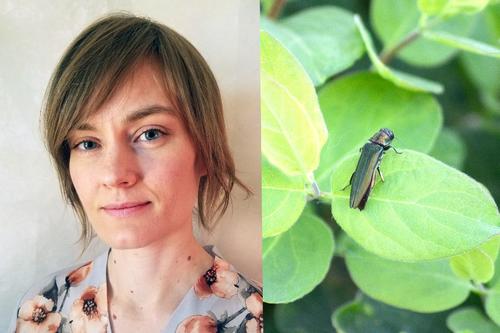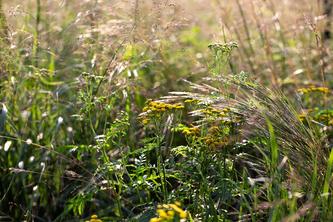
MINNEAPOLIS/ST. PAUL (02/22/2022) — This year, National Invasive Species Awareness Week begins Monday, February 28, and lasts through Friday, March 4. The goal of this week is to raise awareness about the spread of invasive species, the potential threat they pose to our ecosystems and resources, and the work researchers are doing to find solutions.
Amy Morey, a researcher with the Minnesota Invasive Terrestrial Plants and Pests Center (MITPPC) in the College of Food, Agricultural and Natural Resource Sciences answers questions about terrestrial (land-dwelling) invasive species and the latest interdisciplinary research helping to slow their spread.
Q: What are terrestrial invasive species and which species are prevalent in Minnesota?
“Terrestrial” refers to the land. The terrestrial habitats that MITPPC focuses on are prairies, forests, wetlands and agricultural systems. An “invasive” species is one that does not historically occur in an area and can harm the environment, economy and/or human health. Terrestrial invasive species are estimated to cost Minnesotans an estimated $3 billion each year by threatening the health of our ecosystems, recreation, natural resources and food systems. Terrestrial invasive species Minnesotans may be particularly familiar with are common and glossy buckthorn, emerald ash borer, spotted knapweed and Dutch elm disease. However, there are hundreds of others and additional species continue to regularly arrive into the state.
Q: Are invasive species found in Minnesota all year round?
There are many invasive species that have established in Minnesota and live here year-round. But like humans, most tend to be less active when it is cold and, as result, are less likely to be seen during winter. Often species go dormant in sheltered places, like in the soil, under leaves or within the wood of trees.
A few species, though, can be easier to spot during winter. For example, the yellow and red berries of invasive bittersweet stay on the plant during winter and make the plant more visible on the landscape. The brown marmorated stink bug will often overwinter in houses and other buildings, and though they are much less active, you might find one (or a hundred!) walking across your floor or hanging out in your attic. For some species, like the spotted lanternfly, we don’t yet know if they do (or could, if given the chance) stick around all year. The cold winters in Minnesota help keep many invasive species from surviving here, but that is changing with climate change.
Q: What types of terrestrial invasive species research does MITPPC conduct?
At MITPPC, we currently fund research on terrestrial invasive plants, plant pathogens and invertebrates (like insects and worms) that harm valued plants. So, species that are primarily human or animal health concerns are outside of our scope. We support research projects that are practical and science-based in their approach to managing invasive species, whether innovating new methods of early detection, like for Palmer amaranth, or finding new solutions for species that have been around for a long time, like Dutch elm disease. We strongly encourage interdisciplinary work, and our researchers often collaborate with stakeholders outside the university and across the state. This short video highlights many of our recent research projects. You can also learn more about invasive species research and new discoveries through our monthly newsletter, Twitter and website.
Q: With hundreds of terrestrial invasive species in the state, how does MITPPC prioritize where to focus research efforts?
The state legislature asked MITPPC to focus our efforts on the most threatening terrestrial invasive species to Minnesota. To do this, we brought in a group of 15 experts on terrestrial invasive species in Minnesota and asked them to come up with criteria they would use to describe how threatening an invasive species is. Their list, which included 17 criteria related to the likelihood that a species could arrive and survive in Minnesota and the kind of harm their presence could cause, serves as the framework we use to evaluate the riskiness of each species we consider. Based on our evaluation, a numerical score is calculated for each species and they are ranked relative to each other, with species that are more threatening to Minnesota getting higher scores. Projects that involve at least one of the top 15 most risky plants, plant pathogens or invertebrates are where we direct our research funds. However, we regularly reassess the rankings of species based on new discoveries or if new species are evaluated, so the top species can change over time. You can see our current species rankings and details about our prioritization process on MITPPC’s website.
In addition to focusing on a prioritized list of invasive species, MITPPC projects must be applied research that clearly impacts the management of invasive species in the state. We have four research themes for projects to choose from to demonstrate their management impact: early detection, management alternatives, response to climate change and socio-economic issues.
Q: How can I help in the fight against terrestrial invasive species?
Awareness is a great place to start. Learn how to recognize species that might be in your area and then report any that you find to an online database, like Report a Pest or EDDMapS. Simply keeping tabs on the whereabouts of species can be a big help to researchers and land managers. A lot of species are moved around unintentionally by human activity, so also become aware of how slight changes in your behavior can help reduce spreading invasive species. There is a national campaign (with Minnesota roots!) directed at reducing the spread of invasive species that has a lot of helpful information.
Additionally, multiple MITPPC research projects have opportunities for people to be involved as citizen scientists. The MN Department of Agriculture and MN Department of Natural Resources are also great places to find opportunities to learn about and participate in activities related to Minnesota invasive species. Lastly, contact your legislators to tell them how important invasive species research is to you – without support from the Environmental and Natural Resources Trust Fund, MITPPC’s work would not be possible.
Amy Morey is a staff researcher at MITPPC. Her areas of expertise include entomology, pest management and ecological risk assessment.
-30-
About the Minnesota Invasive Terrestrial Plants and Pests Center
The Minnesota Invasive Terrestrial Plants and Pests Center (MITPPC) was founded in 2015 by the Minnesota Legislature to research the prevention, detection and control of terrestrial invasive species. MITPPC researchers use transformative science to prevent and minimize the threats posed by land-based invasive plants, pathogens, and pests. MITPPC is the only research center of its kind in the country, and the center's work to protect the state's native prairies, forests, wetlands, and agricultural resources benefits all of Minnesota and beyond. Funding for MITPPC is provided by the Minnesota Environment and Natural Resources Trust Fund as recommended by the Legislative-Citizen Commission on Minnesota Resources (LCCMR). Learn more at mitppc.umn.edu.
About the College of Food, Agricultural and Natural Resource Sciences
The University of Minnesota’s College of Food, Agricultural and Natural Resource Sciences (CFANS) strives to inspire minds, nourish people, and sustainably enhance the natural environment. CFANS has a legacy of innovation, bringing discoveries to life through science and educating the next generation of leaders. Every day, students, faculty, and researchers use science to address the grand challenges of the world today and the future. CFANS offers an unparalleled expanse of experiential learning opportunities for students and the community, with 12 academic departments, 10 research and outreach centers across the state, the Minnesota Landscape Arboretum, the Bell Museum of Natural History, and dozens of interdisciplinary centers.
About “Talking...with U of M”
“Talking...with U of M” is a resource whereby University of Minnesota faculty answer questions on current and other topics of general interest. Feel free to republish this content. If you would like to schedule an interview with the faculty member or have topics you’d like the University of Minnesota to explore for future “Talking...with U of M,” please contact University Public Relations at [email protected].
- Categories:
- Agriculture and Environment
- Environmental health





